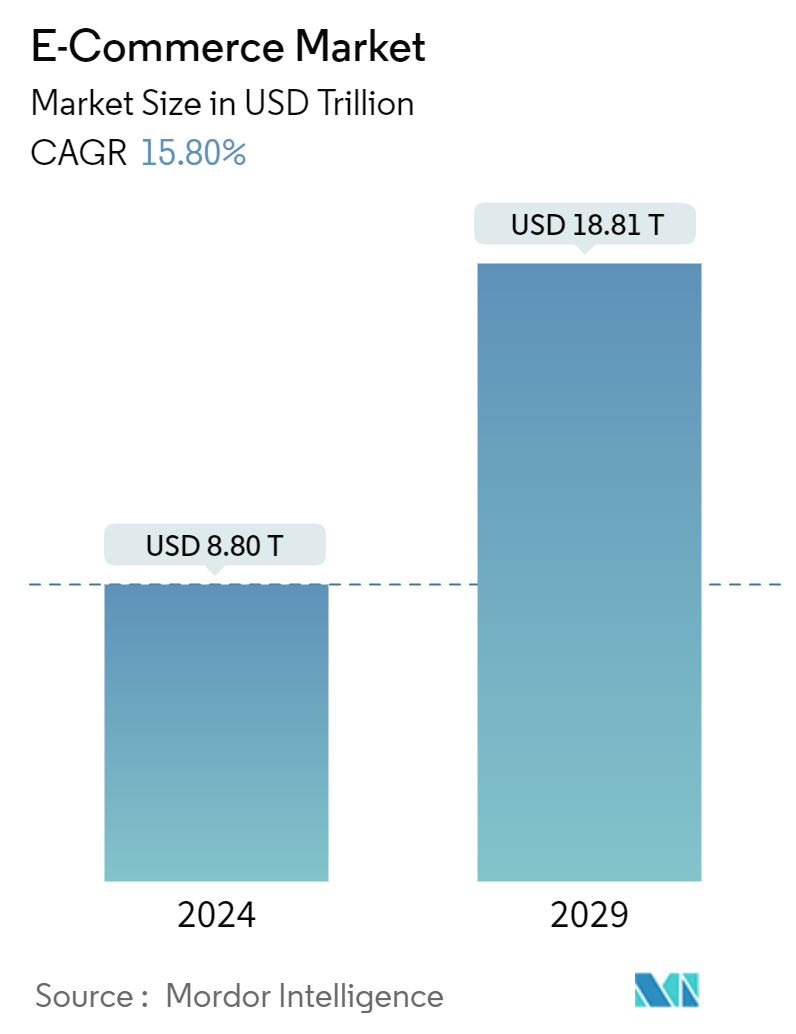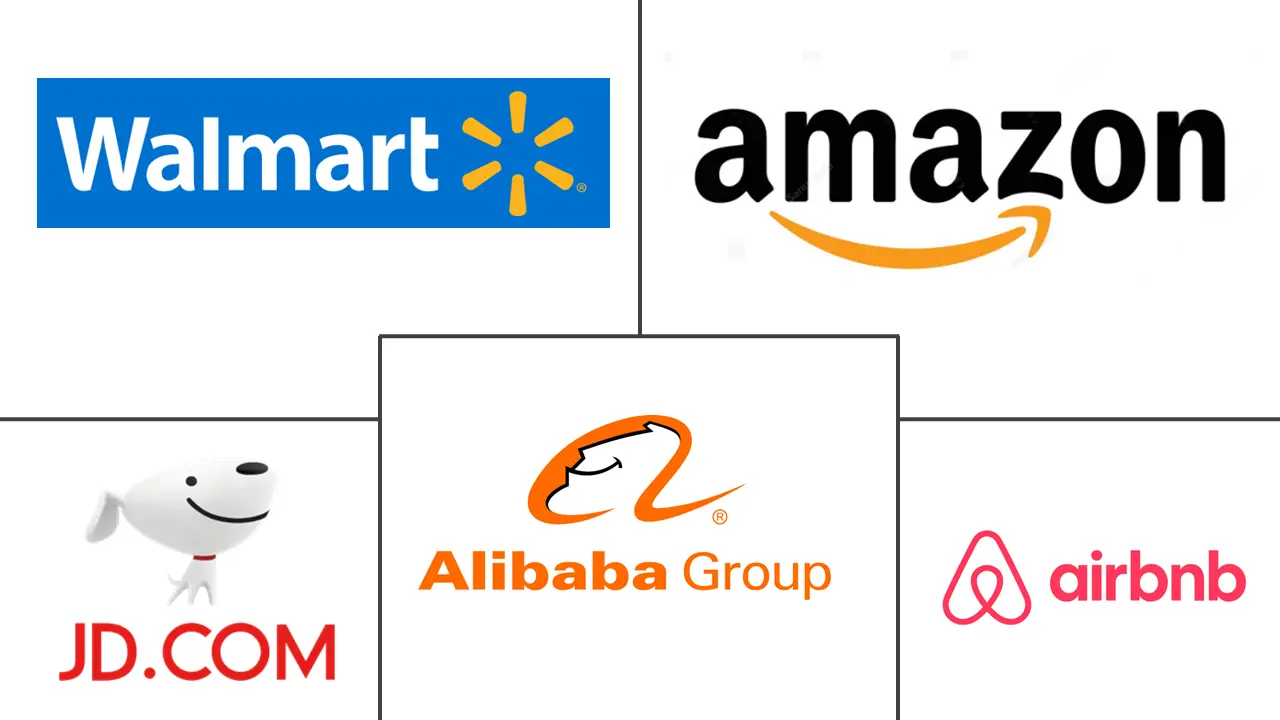Market Size of E-Commerce Industry

| Study Period | 2019 - 2029 |
| Market Size (2024) | USD 8.80 Trillion |
| Market Size (2029) | USD 18.81 Trillion |
| CAGR (2024 - 2029) | 15.80 % |
| Fastest Growing Market | Asia Pacific |
| Largest Market | North America |
Major Players
*Disclaimer: Major Players sorted in no particular order |
E-commerce Market Analysis
The E-Commerce Market size is estimated at USD 8.80 trillion in 2024, and is expected to reach USD 18.81 trillion by 2029, growing at a CAGR of 15.80% during the forecast period (2024-2029).
The global smartphone user population is increasing as the internet's penetration increases. Digital content, financial services, travel and leisure, and e-tailing, to name a few, are among the e-commerce possibilities available to the internet-connected client base, which is growing in popularity as internet usage rises. As a result, customers' technical knowledge is projected to impact market growth positively.
- Due to the lower cost of communication and infrastructure, established businesses and giant corporations are gravitating toward online business. E-commerce allows the organization to reach out to clients more efficiently, resulting in essential exposure to the firm. Online marketing tools such as Google advertisements and Facebook ads also drive e-commerce.
- Small and medium-sized businesses are expanding significantly, especially in India, China, South Africa, and Russia. Initiatives like Make in India and Start-up India have increased the number of start-ups that use the Internet marketplace to conduct business, boosting the market growth. The absence of deployment of technical infrastructure in rural parts of nations such as India, China, and Brazil is predicted to stifle market expansion.
E-commerce Industry Segmentation
E-commerce refers to selling clothing, electronics, furniture, books, cosmetics, and other items over the Internet. Companies that provide home delivery services, such as e-commerce and m-commerce, are included in this industry.
Retailers and their consumers conduct sales transactions using information technology, such as the telephone and the Internet, and merchandise is often delivered via mail or courier. Direct mailers that sell their merchandise and retail through online websites are also included in the e-commerce industry.
The e-commerce market is segmented by B2C e-commerce (beauty and personal care, consumer electronics, fashion and apparel, food and beverage, furniture, and home), B2B e-commerce, and geography (North America (United States, Canada), Europe (Germany, the United Kingdom, France, Spain, Italy, and the Rest of Europe), Asia-Pacific (China, Japan, India, South Korea, and the Rest of Asia-Pacific), Latin America, and the Middle East and Africa).
The market sizes and forecasts are provided in terms of value (USD) for all the above segments.
| By Type | |||||||||||
| |||||||||||
|
| By Geography*** | |||||||
| |||||||
| |||||||
| |||||||
| Australia and New Zealand | |||||||
| Latin America | |||||||
| Middle East and Africa |
E-Commerce Market Size Summary
The e-commerce market is poised for significant expansion, driven by the increasing penetration of the internet and the growing smartphone user base. As consumers become more tech-savvy, the appeal of digital platforms for various services such as e-tailing, financial services, and travel is on the rise. This shift is further bolstered by the cost-effectiveness of online business models, which allow companies to reach a broader audience with enhanced efficiency. The proliferation of online marketing tools like Google and Facebook ads also contributes to this growth. Small and medium-sized enterprises, particularly in regions like India, China, South Africa, and Russia, are leveraging initiatives such as Make in India and Start-up India to tap into the e-commerce space, thereby fueling market development. However, the lack of technological infrastructure in rural areas of these countries poses a challenge to sustained market growth.
The e-commerce sector is experiencing a transformation as mobile devices become the preferred channel for online shopping, supported by advancements in technology such as branded shopping apps and 5G Wi-Fi. Retailers are increasingly adopting strategies like virtual shopping and augmented reality to enhance customer engagement. Government initiatives, such as India's Digital India program and the development of Bharat Craft, are playing a crucial role in promoting e-commerce by providing platforms for small and medium enterprises and improving infrastructure. These efforts are complemented by international collaborations, such as the WTO Joint Statement Initiative, aimed at regulating the global digital economy. Major players like Amazon, Alibaba, and Walmart are actively expanding their presence and investing in local markets to maintain competitiveness. Despite the challenges, the e-commerce market is set for robust growth, with a focus on integrating local solutions and enhancing consumer experiences across multiple platforms.
E-Commerce Market Size - Table of Contents
-
1. MARKET INSIGHTS
-
1.1 Market Overview
-
1.2 Industry Attractiveness- Porter's Five Forces Analysis
-
1.2.1 Bargaining Power of Suppliers
-
1.2.2 Bargaining Power of Buyers/Consumers
-
1.2.3 Threat of New Entrants
-
1.2.4 Threat of Substitute Products
-
1.2.5 Intensity of Competitive Rivalry
-
-
1.3 Key Market Trends and Share of E-commerce of Total Retail Sector
-
1.4 Impact of COVID-19 on the E-commerce Sales
-
-
2. MARKET SEGMENTATION
-
2.1 By Type
-
2.1.1 By B2C ecommerce
-
2.1.1.1 Market Size (GMV) Estimates and Forecasts
-
2.1.1.2 By Application
-
2.1.1.2.1 Beauty & Personal Care
-
2.1.1.2.2 Consumer Electronics
-
2.1.1.2.3 Fashion & Apparel
-
2.1.1.2.4 Food & Beverage
-
2.1.1.2.5 Furniture & Home
-
2.1.1.2.6 Other Applications (Toys, DIY, Media, etc.)
-
-
-
2.1.2 By B2B ecommerce
-
2.1.2.1 Market Size (GMV) Estimates and Forecasts
-
-
-
2.2 By Geography***
-
2.2.1 North America
-
2.2.1.1 United States
-
2.2.1.2 Canada
-
-
2.2.2 Europe
-
2.2.2.1 Germany
-
2.2.2.2 United Kingdom
-
2.2.2.3 France
-
2.2.2.4 Spain
-
2.2.2.5 Italy
-
-
2.2.3 Asia
-
2.2.3.1 China
-
2.2.3.2 Japan
-
2.2.3.3 India
-
2.2.3.4 South Korea
-
-
2.2.4 Australia and New Zealand
-
2.2.5 Latin America
-
2.2.6 Middle East and Africa
-
-
E-Commerce Market Size FAQs
How big is the E-Commerce Market?
The E-Commerce Market size is expected to reach USD 8.80 trillion in 2024 and grow at a CAGR of 15.80% to reach USD 18.81 trillion by 2029.
What is the current E-Commerce Market size?
In 2024, the E-Commerce Market size is expected to reach USD 8.80 trillion.

